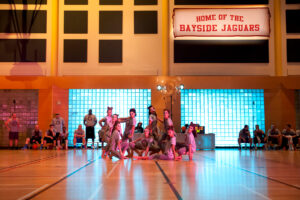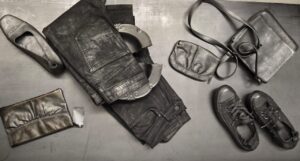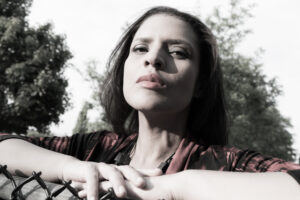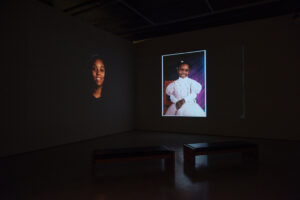Rick Leong is a west-coast artist that uses the language of the landscape to reflect on the ways that we move through and inhabit the landscapes we dwell within, and to explore how we connect to urban and wild ecologies. Drawn from observation and influenced by traditional Chinese art forms and methodologies, Leong’s work investigates the interconnectedness of the land with the subjectivity of human experience. Leong obtained his MFA from Concordia University (Montréal, 2007), and his work was acquired by the Montréal Museum of Fine Arts. He has exhibited his work at the National Gallery of Canada (Ottawa), the Power Plant (Toronto) and the Contemporary Art Gallery (Vancouver). In addition to having participated in many group exhibitions at various Canadian and international spaces, Leong has exhibited solo at Two Rivers Gallery (Prince George), Anna Leonowens Gallery (Halifax), and the Art Gallery of Greater Victoria. Recent exhibitions include Arsenal Contemporary (New York), Bradley Ertaskiran (Montréal), Phi Foundation (Montréal), and the Esker Foundation (Calgary).
- Home
- Exhibitions + Displays
- Rick Leong: Hard Look Soft Gaze
Rick Leong: Hard Look Soft Gaze
February 17, 2023 - October 22, 2023
Third Floor
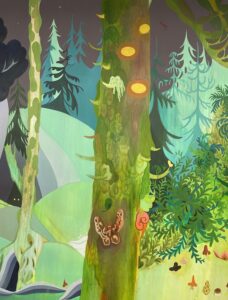
Hard Look Soft Gaze is a reflection on pictorial representations of the landscape, and the place that they occupy in our lives and our collective imagination. For this exhibition, artist Rick Leong was invited to select and curate works depicting landscapes from AWE’s collection of nearly 4,000 works, and to activate them by creating a painting of his own. Leong’s newly-finished large-scale work, titled A Landscape Both Appearing and Disappearing (2021-2022), is presented here alongside 30 works from AWE’s collection, evoking the ways in which we move through and inhabit the landscapes around us. Hard Look Soft Gaze is part of a series of exhibitions in which artists are invited to curate and respond to the works in AWE’s collection.
To take a long, hard look at something means to examine it very carefully in the hope of improving it. A Landscape Both Appearing and Disappearing attempts to capture the disappearing landscape of an old-growth temperate rainforest through a panoramic shift—from light to dark, and from dark to light—of a rising and setting sun. All forests are in a constant state of flux, continually migrating at the glacial pace that they have evolved to within the pace of climate change. As old-growth forests age and eventually die, the species of trees slowly shift to adapt to the conditions of their ecosystems. These changes occur over the course of centuries, giving the flora and fauna time to adjust and continue to thrive. With human intervention, the pace of these changes has changed so radically that the trees and flora can no longer adapt. Forests are disappearing from places they have inhabited for centuries, and new ones are cropping up in places that have never seen forests before, such as in the arctic tundra. Clear-cut old-growth will never be allowed to become old-growth again. They will be replaced with different kinds of trees that are less conducive to the vigour of the ecosystems they are meant to replenish, having been chosen to maximize short-term economic gain. We are witnessing a time of great change when it comes to our relationship with the landscapes we inhabit. We now know that widespread industrial extraction is no longer tenable or sustainable in the way that we have been doing it in the past. Now is the time to take a hard look at our relationship with the landscape before the ecosystems that we are a part of no longer exist, so that we can better understand if and how we might fit within it. A Landscape Both Appearing and Disappearing is not a refutation of change, but an attempt to document and capture this landscape’s essence within its spatio-temporal context, before it fades into an unknown future.
A soft gaze allows the periphery of your vision to seep into your focus. It provides context and situational awareness, allowing us to see the bigger picture—to see the whole forest instead of a single tree. Displaying 30 landscapes on a single wall necessitates a soft gaze through which we can take them all in—one must look at the forest. These landscapes begin with a painting that predates 1600 and spans all the way into the here and now. A multitude of perspectives from artists bridging such a great timespan offers glimpses into our relationship with the landscape over the centuries. These works provide insight into how we made it to the present moment. I hesitate to reframe or recontextualize the diverse perspectives represented within this salon, knowing all too well that they will be experienced through the lens of the viewer’s lived experience—but also because I do not wish to strip the artists of their voices and their agency. My work is not a direct response to the exhibited paintings; nor a critique of their perspectives; nor a comment on the artists’ individual practices. In bringing these works into view, I seek to gain insight into our relationship with the land through the genre of landscape painting; to find a path to an idealized future in an individual way. Arranged chronologically from left to right in a salon, the viewer must move parallel to the horizon with a soft gaze. One must refocus their gaze to appreciate the perspective created within each work. I would dare to venture that many of the paintings found within this collection of works represent an idealized view. The seductive materiality and processes of painting and the tendency to romanticize the landscape are a means of re-establishing a meaningful relationship with nature. Utopias can only ever exist in the past or the future. Yet utopian landscapes can be critical in helping us to imagine the kinds of future landscapes we want to inhabit. They form a vision of a future that we can work towards, no matter how fantastical or impossible they may seem to us now. Forests change. Landscapes change. People change. We know now, without a doubt, that we are the principal drivers of change in the world, and we have a collective decision to make about what we change it into. Through looking at past manifestations of idealized landscapes, we are given the tools to imagine our future.
Rick Leong
Meet the Artist and Curator: Rick Leong
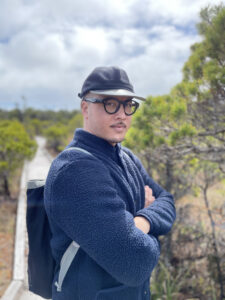
Media

Joos de Momper. Village on a River—Treviso, prior to 1600. Oil on panel, 50x 92 cm. Given in memory of Mr. and Mrs. Kenneth E. Fleming by their children, 1983.
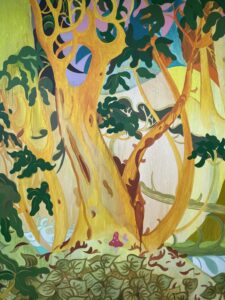
Detail of work in progress "Landscape Both Appearing and Disappearing". Photograph by Mike Mclean.

Detail of work in progress "Landscape Both Appearing and Disappearing". Photograph by Mike Mclean.

